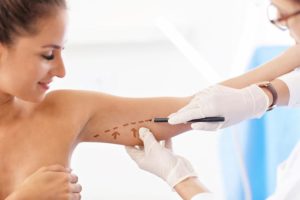What is this procedure?

A brachioplasty, commonly called an arm lift, is a surgical procedure to reshape and provide improved contour to the upper arms and connecting area of chest wall. While “brachioplasty” is commonly used to describe a specific procedure for the upper arms, the term can also be used to describe any surgical arm contouring. Brachioplasty is often used to address issues such as excessive loose skin or excessive fat in the arms when it does not respond well to diet and exercise. Brachioplasty is a common procedure for patients who have experienced massive weight loss and has gained popularity since 2000.
An arm lift is a cosmetic surgical procedure to improve the appearance of the under portion of your upper arms. During an arm lift — also known as brachioplasty — excess skin and fat are removed from between the armpit and elbow. The remaining skin is placed back over the newly repositioned contours to create a more toned look.
Who needs this procedure?
As you get older, the skin on your upper arms changes — sagging and becoming loose. Significant weight loss also can cause the undersides of your upper arms to droop. While exercise can strengthen and improve muscle tone in the upper arm, it can’t address excess skin that has lost elasticity. You might choose to have an arm lift if the undersides of your upper arms are sagging. An arm lift might also boost your body image.
What is the advantage of this procedure?
TAn arm lift is a surgical procedure done to create smoother, more toned and better contours of the arms. For people who have lost a significant amount of weight or suffer from excess skin around the lower part of the arms, this procedure can prove incredibly beneficial. An arm lift (a.k.a. brachioplasty) must be done by a board-certified surgeon and you will need to book some time off work to recover. However, once you’ve healed, you’ll notice how gorgeous your arms are. Why? Because an arm lift has eight major benefits. These benefits are:
- Excess fat and skin are removed: When you undergo an arm lift procedure, the excess fat and skin that hang below your lower arms are removed. This dramatic reduction in skin and fat leave a more desirable appearance in the area between the armpit and elbow. The excess fat will be removed via liposuction and the excess skin is surgically excised.
- Change in tone and shape: An arm lift will change the shape of your arms, allowing them to appear more toned. Before an arm lift, your upper arms may appear flabby, no matter how much you work out. That is because there is too much excess skin or fat in the way. But, after your arm lift procedure the shape of your arms will change and the flabbiness will be completely gone, because the surgeon will reshape the underlying tissue, making the tissue and the tendons in your arms more supportive.
- Improved contours: Arm lift surgery helps restore the skin’s elasticity, something that is lost through aging or weight gain followed by weight loss. Once the elasticity is restored, you’ll notice improved arm contours.
- Better proportions: After undergoing a brachioplasty procedure your arms will now be proportionate to the rest of your body. For example, if you’ve lost a significant amount of weight or your arms were sagging due to the effects of gravity and aging, an arm lift removes excess skin and fat and your entire body will appear more balanced.
- Scars are hidden: As with any surgical procedure there is slight scarring. However, with an arm lift the scars are hidden either in the inner arm, at the armpit or at the back of the arm. These scars are so minimal that they will not be noticeable to the naked eye. Plus, there are creams you can use to reduce the appearance of scarring if need be, but scars generally dissipate on their own.
- Confidence is restored: Arm lifts restore your self-esteem. Before your arm lift you may have felt self-conscious about the way your arms looked. After an arm lift you will have no trouble showing off your toned, smooth arms because of their taut appearance.
- More clothing options: Following an arm lift, you may notice that your shirt size has gone down. You may have needed to wear a size medium but after having brachioplasty you now fit into a size small. An arm lift can give you more clothing options and you’ll be less self-conscious to wear sleeveless tops in public.
- Better workout results: Before your arm lift you may have lifted weights and done arm exercises but to no avail. After your arm lift you’ll notice that without the excess skin and tissue, you’ll be stronger. You’ll see the results of a workout easily and you’ll also find lifting weights and performing arm exercises a breeze.
Are there non-surgical treatments?

In place of a scalpel, the scar less arm lift uses radiofrequency-assisted liposuction to liquefy and remove unwanted fat cells, and provide lasting skin tightening. The BodyTite arm lift is FDA approved and very effective for tightening the upper arms without surgery and its requisite scarring.
Doctor inserts the BodyTite radiofrequency probe through a small incision made in the skin which will provide very minimal scarring. The radiofrequency (RF) energy converts to heat under the skin and it liquefies the unwanted fat cells, which are then removed with a thin cannula. The RF energy also causes a skin tightening reaction in the treatment area. The body perceives the heat from the RF energy as a “wound” and it responds by remodeling collagen in the area and tightening the skin. This tightening process continues for months afterward.
In a typical brachioplasty, Dr. makes an incision on the inside of the upper arm. This incision usually runs all the way from the elbow to the armpit. She then removes excess fat pockets with liposuction, repositions and tightens the underlying muscle tissue, and trims away excess skin. Surgical arm lifts require a one- to two-week recovery before returning to work. Also, the patient needs to avoid lifting any heavy objects for at least one month.
Scar less arm lifts only need a very small incision to insert the radiofrequency probe and the cannula to suction out the liquefied fat. The tiny incision is unnoticeable in a few months. Patients return to work in just one to three days, and there is very little discomfort. These are other benefits: Surgery without the scarring, immediate skin tightening, little swelling and bruising, Minimal downtime, little discomfort and pain
What is the surgical treatment like local or sedation?
Yes it can be done with some intravenous sedation. There may be a disadvantage in terms of the amount of skin that can be removed as the local anesthesia causes the skin to swell. This swelling in the arm, makes it difficult to close the incision so you may be able to remove more skin under general anesthesia with no local (that causes skin swelling).
What is the recovery like?
1 to 3 Days Following Surgery: Patients will experience light to moderate pain following their procedure. The pain is usually well controlled with prescribed medication and/or anti-inflammatories such as Advil or Aleve. Post procedure the arms will be bandaged and wrapped. This will result in some decrease in range of motion of the arms. Swelling of the hands can be expected even while drains are in place. The patient will be instructed not to wear rings or any other jewelry until swelling has resolved, along with elevation of the arms (hands over heart) while sleeping. Due to limited mobility in the early stage of recovery the patient should wear a loose button up shirt until cleared by his or her surgeon.
1 Week Following Surgery: Pain typically subsides to the point where most patients no longer require pain medication. Swelling and bruising of the arms will be decreasing but will still be apparent and may continue.
2-3 weeks following the procedure. 10 Days Following Surgery: Stitches, bandages, and drainage tubes are removed. Arm mobility increases, however patients are still advised to avoid stretching or lifting anything heavy. Most patients are able to return to work and normal daily activities including showering. Your surgeon may advise you to wear a compression garment which will help the healing process.
2 Weeks Following Surgery: Patients typically begin a scar therapy plan that consists of either a silicone based tape product or a scar cream.
4 to 6 Weeks Following Surgery: Bruising and swelling should be completely subsided revealing the final results of the procedure. Most patients will no longer need to wear compression garments. Patients may gradually resume their exercise regimen. At 6 weeks most patients are cleared by their surgeon to resume heavy lifting and other type of intense arm activity like tennis and golf. Most patient continue their scar management plan for the next 4-6 months.
6 Months Following Surgery: Scarring at incision sites become better blended with surrounding skin leaving it less noticeable. The scars will continue to improve for up to 2 years after the arm lift.
How long does it take?
One of our board certified surgeons will make an incisions on the undersides of your arms. The length and pattern of the incisions depends on how much skin will be removed. After making the incisions, the plastic surgeon will tighten your underlying tissues and secure them with stitches. He or she might also use a suction technique to remove fat (liposuction). Your skin will then be draped over the new contours and excess skin will be removed. Stitches or surgical tape will be used to close the incisions.
- Step 1 – Anesthesia
Medications are administered for your comfort during arm lift surgery. The choices include intravenous sedation and general anesthesia. Your doctor will recommend the best choice for you. - Step 2 – The incision
Incision length and pattern during arm lift surgery depend on the amount and location of excess skin to be removed, as well as the best judgment of your plastic surgeon. Incisions are generally placed on the inside of the arm or on the back of the arm, depending on the surgeon’s preference, and may extend from the underarm (axilla) to just above the elbow. Excess fat may be directly excised or treated with liposuction. Depending on your specific condition, incisions may be more limited. Then, underlying supportive tissue is tightened and reshaped with internal sutures. Finally, the skin is smoothed over the new contour of your arm. - Step 3 – Closing the incisions
Your incisions will be closed either with absorbable sutures or stitches that will be removed within one to two weeks following your arm lift. - Step 4 – See the results
The smoother, tighter contours that result from brachioplasty are apparent almost immediately following your procedure, although there will likely be swelling and bruising. Get more information about arm lift surgery results.
How long has it been around?
 Revolutionary to body contouring, liposuction was initially popularized in New York in the late 1970s. Prior to liposuction, Correa-Iturraspe and Fernandez first described arm reduction surgery, mainly brachioplasty, in 1954 in the South American literature. Since that time, modifications of brachioplasty (ie, T-closure, Z-plasties, fascial system suspensions) have been the emphasis of upper arm contouring. With the introduction of liposuction to the United States in 1981 and the tumescent technique in the late 1980s, liposuction of the upper arms has gained popularity. Liposuction of the upper arms has also been used as an adjunct to body contouring after massive weight loss.
Revolutionary to body contouring, liposuction was initially popularized in New York in the late 1970s. Prior to liposuction, Correa-Iturraspe and Fernandez first described arm reduction surgery, mainly brachioplasty, in 1954 in the South American literature. Since that time, modifications of brachioplasty (ie, T-closure, Z-plasties, fascial system suspensions) have been the emphasis of upper arm contouring. With the introduction of liposuction to the United States in 1981 and the tumescent technique in the late 1980s, liposuction of the upper arms has gained popularity. Liposuction of the upper arms has also been used as an adjunct to body contouring after massive weight loss.
Arm reduction surgery dates back to the 1950’s. Information on this procedure was found in South African Literature written by Correa-Iturraspe and Fernandez. There are new advanced ways of doing the procedure in comparison to decades ago, but this surgery is not as “new age” as some may believe. The advancements that have been made are related to the technique used to excise the fat, the area excised, the location of the incisions, and length of the incisions.
In the 1950s, the techniques used mainly addressed patients’ concerns with skin laxity (looseness) due to aging and normal weight-loss. The techniques used then, made incisions on the upper arm and later over the armpit. These techniques are rarely still be used by some doctors. Nowadays, there are various forms of incisions available, but each one depends on which “zone” of the arm a patient would like plastic surgery to be performed on.
What are the complications?
he decision to have plastic surgery is extremely personal, and you’ll have to decide if the benefits, risks and potential complications of arm lift surgery are acceptable.
You will be asked to sign consent forms to ensure that you fully understand the procedure.
Arm lift surgery risks include:
- Anesthesia risks
- Bleeding
- Infection
- Poor wound healing
- Unsightly scarring
- Fluid accumulation (seroma)
- Damage to deeper structures such as nerves, blood vessels and muscles
- Fatty tissue under the skin might die (fat necrosis)
- Numbness or other changes in skin sensation
- Pain, which may persist
- Sutures may not absorb, but spontaneously surface through the skin, causing irritation, drainage and redness
- Possible need for revisional surgery
These risks and others will be fully discussed prior to your consent. It’s important that you address all your questions directly with your plastic surgeon.
Some of the possible complications associated with brachioplasty include:
- Risks of anesthesia, including allergic reaction
- Surgical risks such as bleeding or infection
- Blood clots that may cause potentially fatal cardiovascular complications, such as heart attack, deep vein thrombosis or stroke
- Collapsed lung
- Fluid build-up under the wound
- Tissue death along the wound, or skin loss
- Sensory nerve damage, which may cause prolonged or permanent numbness in the upper arm or even in the forearm
- Prolonged swelling
- Damage to underlying tissues such as muscles
- Asymmetry (unevenness) of the skin
- Unsightly, inflamed or itchy scarring
- Further surgery to treat complications.
An arm lift poses various risks, including:
- Scarring. Incision scars from an arm lift are permanent, but are typically placed in areas that aren’t easily visible. Rarely, incisions can result in raised, red scars. Injections of a corticosteroid medication or other treatments might be used to improve the appearance of scars.
- Asymmetry in the shape of your arms. This could occur as a result of changes during the healing process. Also, while the surgeon will try to make your arms look as symmetrical as possible, perfect symmetry isn’t possible.
- Changes in skin sensation. During an arm lift, the repositioning of your arm tissues can affect superficial sensory nerves. You’ll likely feel some temporary numbness.
- Problems with stitches. Stitches used to secure the arm’s new shape might work their way to the surface of the skin and need to be removed. This can cause inflammation of the affected skin. As a result, you might need additional surgery.
Like any other type of major surgery, an arm lift poses a risk of bleeding, infection and an adverse reaction to anesthesia.
An arm lift isn’t for everyone. Your doctor might caution against an arm lift if you:
- Are significantly overweight
- Have frequent changes in your weight
- Have a medical condition that interferes with wound healing
- Are a smoker
What can you do to speed up recovery?
 In the first few days after an arm lift:
In the first few days after an arm lift:
- Avoid lifting your arms above shoulder level for three to four weeks.
- Avoid physical and athletic activities with your arms that might stretch the incisions for four to eight weeks after surgery.
- Take pain medication as needed and use topical or oral antibiotics as directed to prevent wound infections.
- Always follow all post-procedure care instructions provided by your surgeon
- Immediately contact your surgeon if you have any questions or concerns about your recovery
- Make sure to designate a caregiver for help around the house (especially over the first 7-10 days as your arms will be immobile)
- Attend all scheduled follow up appointments with your provider
- Take prescribed pain medication as directed
- Plan on 1-2 weeks off work
- Refrain from any activity until cleared by your surgeon
- Sleep with your arms elevated on pillows to decrease swelling and discomfort
- Plan on wearing loose fitting tops that open in the front rather than having to be pulled over your head
- Avoid touching the incision site or removing bandages to exam your wound
- Get plenty of rest and sleep
- Eat lighter and healthier foods and drink lots of water
Do you need to rest up afterwards and for how many days?
After an arm lift, your incisions will be covered in bandages. Your arms will be loosely wrapped in elastic bandages to minimize swelling. Small tubes might be placed in your arms to drain any excess blood or fluid.
You’ll likely see someone from your plastic surgery team within a day or two after your arm lift. He or she may remove your bandages and drainage tube if used. Some plastic surgeons may have you wear a compression sleeve for a few weeks to keep swelling down.
During your recovery from arm lift surgery, dressings or bandages may be applied to your incisions, and your arms may be wrapped in an elastic bandage or a compression garment to minimize swelling following surgery.
A small, thin tube may be temporarily placed under the skin to drain any excess blood or fluid.
You will be given specific instructions on how to care for the surgical site and drains, medications to apply or take orally to aid healing, specific concerns to look for and when to follow up with your plastic surgeon.
Contact us to find out more.
